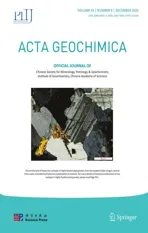Groundwater arsenic poisoning in a primary educational institution: health risks to school-going children
2022-12-22MdSohelRanaMdJahangirAlamMdAbuMusaSazalKumarMdAminurRahman
Md.Sohel Rana • Md.Jahangir Alam • Md.Abu Musa • Sazal Kumar •Md.Aminur Rahman
Abstract This study aimed to estimate arsenic (As) and iron (Fe) content in tubewell water (n = 58) in primary educational institutions and subsequently assess the health risks to school-going children.Results described that the As concentration ranged between 0.002 and 0.994 mg L-1 with an average value of 0.044 mg L-1; which exceeded the World Health Organization (WHO) provisional guideline value of 0.01 mg L-1.Similarly,the Fe content varied from 0.05 to 10 mg L-1 averaging to 2.84 mg L-1.Samples of 55.17% contained a greater As concentration than 0.01 mg L-1 and 18.97%greater than Bangladesh drinking water quality (BDWQ) standard of 0.05 mg L-1, respectively.Meanwhile, 75.86% of samples contained a higher Fe concentration than the maximum Bangladesh permissible limit of 1 mg L-1.Health risk assessment indicated that girls are more vulnerable than boys are.The average hazard quotients (HQs) for As intake through drinking water were 6.01 ± 17.85 and 7.41 ± 22.03 for boys and girls, respectively, implying non-carcinogenic health risks to both genders.The HQs for Fe intake were less than threshold value of 1 indicating no health issues may arise from Fe intake alone.However,consumption of As and Fe may trigger health risks to students as indicated by the hazard index (HI), which was higher than 1.The average cancer risk (CR) values for both boys (0.0027 ± 0.008)and girls (0.0033 ± 0.0099) exceeded the threshold limit of 10–6–10–4, suggesting a possibility of lifetime cancer risks to the school-going children.Consequently, school authorities should find alternative ways to ensure safe drinking water for school-going children to avoid possible cancer and non-cancer health risks through consumption of As-poisoning water.
Keywords Arsenic ∙Iron ∙Human health risks ∙Groundwater
1 Introduction
Groundwater, which is collected through tubewells (TW)and for this reason known as tubewell water is the primary source of safe drinking water for 97% of rural inhabitants in Bangladesh (UNICEF 2021).However, the increased use of groundwater resources, natural processes like leaching and weathering, and anthropogenic inputs including mining and industrial activities have seriously endangered groundwater quality (Galhardi and Bonotto 2017; Islam et al.2017a; Smedley and Kinniburgh 2002).Several contaminants affect water quality but in Bangladesh,trace elements,particularly arsenic(As)and iron(Fe)affect the groundwater quality the most (Fendorf et al.2010; Nickson et al.2000).This is due to the natural release of As into the aquifer through reductive dissolution of arsenic-rich iron oxyhydroxide (Nickson et al.2000;Saha et al.2020)
Arsenic is a carcinogenic element and exposure to it from drinking water causes various diseases including cancer (IARC 2018).Chronic exposure to As causes hepatocellular carcinoma, melanosis, hyperkeratosis, diabetes mellitus, hypertension, cancers of bladder, skin and lungs,cirrhosis, liver fibrosis,, IQ impacts in children, cardiovascular systems, endocrine disruption and parenchymal cell damage (Gupta et al.2020; He et al.2014; Rahman et al.2009; Xu et al.2021).Drinking water containing as and Fe can endanger the health of adults and children.Parkinson′s and Alzheimer′s diseases are caused by as exposure (De Vizcaya-Ruiz et al.2009).Yadav et al.(2011) revealed that as exposure may cause impaired hearing, learning, and sleeping.Furthermore, a different dimensional impact was found for As that sulfur-containing protein can react with as(III) to form products that will cause biological malfunction(Smith et al.2000;Wang and Wai 2004).
In contrast to As,Fe is one of the elements essential for human health,specifically for hemoglobin,myoglobin,and a number of enzymes.However,a high concentration of Fe causes vomiting, and diarrhea, with a subsequent effect on the cardiovascular and central nervous systems, liver,kidney, and blood in humans (Goldhaber 2003).Consequently, several studies were conducted on groundwater quality monitoring and estimation of several trace elements in groundwater in Rangpur division.Hydro-chemical evaluation by measuring major cations and physicochemical analysis of groundwater from Rangpur and Dinajpur districts indicated that groundwater can be utilized for drinking and domestic purposes (Saha et al.2019).However, trace elements in groundwater from Rangpur district indicated that the average Fe concentration was higher and As concentration was smaller than the recommended limits published by the WHO and Bangladesh authorities (Islam et al.2019).The study detected that As exposure from drinking water may pose lifetime cancer risks to the population in the study area, where children are at higher risk(Islam et al.2019).Additionally, one study conducted in the Dinajpur district found that Fe concentration in groundwater surpassed the WHO and Bangladesh standard limits (Habib et al.2020).In their study, they did not estimate As in groundwater.
Although several studies were conducted on groundwater pollution from trace elements in northern Bangladesh, none focused on groundwater contamination from trace elements, particularly As and Fe in the tubewells on primary school premises.In contrast to northern Bangladesh, several analyses done in southern and south-western Bangladesh have concentrated on trace element estimation and health risk assessment of trace elements through drinking water from the tubewells in primary schools.For example, in the southwestern Bangladesh district of Magura, As and Fe concentrations in tubewell water from primary schools were estimated (Rahman et al.2016).It emerged that the concentrations of As and Fe were higher than the WHO provisional guideline value and Bangladesh drinking water quality (BDWQ) standard (Rahman et al.2016).Tubewell water from primary schools in Satkhira district in southern Bangladesh revealed that about 49%and 45% tubewell water samples contained higher Fe and As content, respectively, than what the guidelines recommended (Rahman and Hashem 2019).
In many As polluted areas around the world, for example, in Sindh province of Pakistan, As concentration in drinking water was higher than 10 μg L-1in most tubewells, and one health risk assessment model indicated that the children were at risk of chronic As toxicity in the future(Baig et al.2016).Similar findings were reported for school-going children in Punjab, Pakistan (Murtaza et al.2020).Furthermore, Rahman et al.(2021c) and Gul et al.(2020) reported that groundwater in Jessore and Multan districts is not fit for human consumption due to excessive As contamination and high school students are at risk of experiencing chronic and carcinogenic health risks.Moreover, in West Bengal, India, a study revealed that school children in As exposed areas are at a high risk of As exposure through the consumption of contaminated drinking water (Joardar et al.2020).Furthermore, the average As concentration in the drinking water from the exposed area was 7 times higher than 10 μg L-1(Joardar et al.2021).
It should be noted that the tubewells in primary schools are the only source of drinking water for the students during school hours since children do not usually carry drinking water from home.A substantial time is spent in schools and the students drink about 1 L of water during school time, which may cause ingestion of a substantial amount of As and Fe.Excessive intake of As and Fe may cause several diseases as discussed earlier.Children are more vulnerable than adults as they have less developed respiratory, immune, reproductive, central nervous, and digestive systems(Burtscher and Schu¨epp 2012;Madureira et al.2016; Salvi 2007).Consequently, a health risk assessment model has become an important tool in determining human health risks for trace elements intake.This technique has been widely used to determine probabilistic health risks to the population.Even in the current study area, some of the studies used this technique to determine probabilistic health risks to the general population and indicated that children have a great health risk susceptibility to the polluted groundwater in Setabganj sugar mill area (Hossain et al.2020), females in Rangpur city area were more susceptible to the health risk from Fe intake than the males (Hauque et al.2021), and children were at higher cancer and non-cancer risks than adults in Rangpur district from drinking groundwater (Islam et al.2019).However, none of the studies in Rangpur division focused on As and Fe content in drinking water in primary schools and estimated the health risks to the students from drinking water during the school period.
With these issues in mind, for the first time, the present study examined the quality of drinking water of primary schools in different upazilas(sub-districts)of eight districts in northern Bangladesh (Rangpur division).Monitoring was done to quantify As and Fe concentrations using atomic absorption spectrophotometer(AAS)and compared with corresponding national and international provisional safe limits in drinking water.In addition, human health risks were estimated using the United States environmental protection agency (US-EPA) model for school-going children in the study area.
2 Materials and methods
2.1 Study area
The study was conducted in the north-western Bangladesh area known as Rangpur division.The study area consists of eight districts, namely Rangpur (R), Dinajpur (D),Thakurgaon (T), Panchagarh (P), Nilphamari (N), Lalmonirhat (L), Kurigram (K), and Gaibandha (G) (Fig.1).The study area is in fact an alluvial plain with an elevation of 32 m above sea level.The elevation rises from the Pleistocene terraces sloping towards the south and southeast (DPHE/BGS 2001; Rahman and Islam 2019).In Rangpur division, most of its areas are composed of alluvial recent soil and the rest are Barind clay.There are two types of aquifers, namely the upper shallow aquifer in the uplift zone of Rangpur Saddle and the lower aquifer.Coarse-grained sands with widespread gravels are present in the Late Pleistocene to Early Holocene aquifer, while Dupi Tila sand formation is overlayed by the thick silty clay formation of the Pleistocene period.It has formed the Plio-Pleistocene aquifer in the study area (Islam et al.2019).
2.2 Sampling
The drinking water samples were collected from the 58 pre-selected tubewells of primary schools from each subdistrict of eight districts (Fig.1).The water samples were collected directly from the tubewells after purging for at least 20 min in the prewashed high-density polyethylene(HDPE)bottles.Then samples were labeled as D1–D13 for Dinajpur, G1–G7 for Gaibandha, K1–K9 for Kurigram,L1–L5 for Lalmonirhat,N1–N6 for Nilphamari, P1–P5 for Panchagar, R1–R8 for Rangpur, and T1–T5 for Thakurgaon district.Before analysis, the samples were filtrated through a millipore cellulose membrane (0.45 μm) in bottles and acidified with 1% nitric acid (HNO3).All samples were kept in a refrigerator at 4 °C until required for laboratory analysis (Mohana et al.2020).
2.3 Reagents and laboratory analysis
All stock solutions were prepared from the analytical reagents(AR).Freshly prepared double de-ionized distilled water was used in all experiments.Arsenic standard solutions were obtained from Fluka-Analytical Switzerland.20% potassium iodide (Sigma-Aldrich,USA)solution was used to reduce As(V)to AS(III).Arsenic tri hydride(AsH3)generation was done with 5 M HCl(Sigma-Aldrich,USA),and 0.6% sodium boro hydride solution (Sigma-Adrich,USA).
The As and Fe contents were analyzed by an atomic absorption spectrophotometer following the American Public Health Association (APHA) method (APHA 2012).Firstly, the calibration curve was established using the working standard solutions from different concentrations of the certified reference solutions.The As content was measured by the hydride vapor generation (HVG) method,where argon served as the carrier gas and recordings were taken at the wavelength of 193.7 nm(Rahman et al.2016).The Fe content was measured using direct IR acetylene flame at a wavelength of 248.3 nm (Rahman et al.2019).
2.4 Human health risk assessment
The health risk assessment estimates a population’s health to what extent would be at risk of drinking contaminated water.The health risks from non-carcinogenic and carcinogenic exposure arising from the intake of arsenic (As)and iron(Fe)were considered.The US-EPA recommended method was used for health risk assessment, which provides a qualitative estimate of health risks based on provisional standard values.The human non-carcinogenic health risk was evaluated on the basis of chronic daily intake (CDI) of metals and hazard quotient (HQ) for both boys and girls.If the HQ is higher than the threshold value equal to 1, it is assumed that the population might experience non-cancer health symptoms from drinking contaminated water.However, there is no guideline value for the CDI, which only indicates the daily consumption content of pollutants by the people.In addition, carcinogenic risk(CR)was calculated for As,since only As has an oral slope factor value.The threshold limit of CR is 10–6–10–4and if the value is greater than this range, it is expected that the consumers might develop cancer in theirlifespan.TW water is used for cooking, drinking, and bathing, but in school areas, it is primarily used for drinking purposes.Therefore, in human health risks estimation,only water ingestion was considered as the primary exposure route to the children:
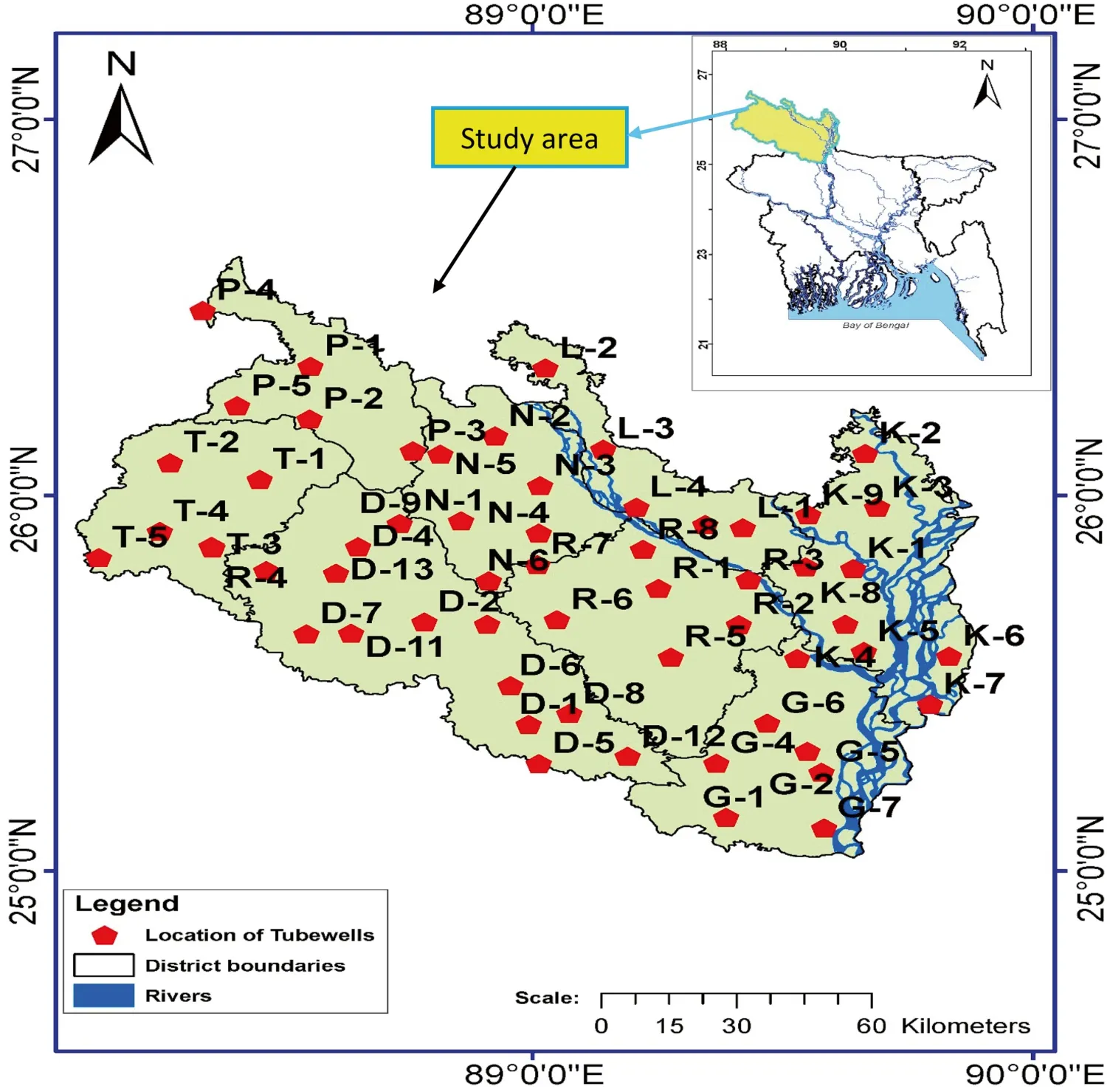
Fig.1 Study area map showing the locations of each sampling point and study area in Bangladesh

where C is the concentration of As and Fe in water(mg L-1);IR is the ingestion rate of water (1 L day-1)for school-going children during school time (Rahman et al.2021a); EF represents the exposure frequency (230 days/year);ED is exposure duration(5 years);AT is the average exposure time (1150 days); and BW denotes the body weight for 6 to 10 years school children.It is noted that the mean body weights of boys and girls are approximately 24.68 and 20 kg, respectively (NCHS 2001).In this study,we have considered 1.0 L water consumption during school hours (about 3–4 h/day) to estimate health risk, although children usually consume 2.1 L of water daily (Hossain et al.2013).This is because, there are two shifts of school time in primary schools in Bangladesh: the morning shift(9:15 am–12:00 pm for class I to II students)and day shift(12:15 pm–4:15 pm for class III to V students),which are subsequently after breakfast and lunch when children drink more water than other time in the day, respectively.Exposure duration was considered based on school opening days annually.Also, water ingestion was considered the major exposure route since students only drink water during the average schooling day; they do not take a bath which is the dermal and inhalation exposure route.
The HQ was estimated using the following equation(US-EPA 2002, 2005):

where RfDo is the oral reference dose of As(0.0003 mg kg-1day-1) and Fe (0.7 mg kg-1day-1)(US-EPA 2005).When the value of HQ <1, the exposed population is safe from certain harmful effects of trace metals.If HQ >1, then this may pose adverse health effects on the exposed population.
Hazard index (HI) is the sum of HQ of As and Fe.It is stated as:

The CR is considered by means of the subsequent formula (US-EPA 2019):

where SF is the oral slope factor for As(mg/kg/day)-1and for As,the value of SF is 1.5(mg kg-1day-1)-1(US-EPA 2019).
3 Results and discussion
3.1 As and Fe in drinking water
Figures 2 and 3 depict the concentrations of As and Fe in groundwater in Rangpur division (north-western part of Bangladesh).The concentration of As in the water samples ranged from 0.002 to 0.994 mg L-1with an average value of 0.044 mg L-1.The highest As content (0.994 mg L-1)was discovered in Pirgacha sub-district in Rangpur (R-2),while the smallest was reported in Parbatipur sub-district in Dinajpur (D - 10) (Fig.1).The WHO provisional guideline value for As in drinking water is 0.01 mg L-1(WHO 2017) while for Bangladesh, it is 0.05 mg L-1(BSB/UNICEF 2011; ECR 1997).The results indicated that about 55.17%(32 out of 58)samples contained a higher As concentration than the WHO guideline value, whereas,about 18.97% (11 out of 58) groundwater contained more than the Bangladesh drinking water quality standard limit of 0.05 mg L-1.The average concentration of As(0.044 mg L-1) in the study area was about 4.5 times higher than the WHO standard but slightly lower than the BDWQ limit (Supplementary Table S1).
Among the 8 districts,the highest As concentration was detected in Rangpur district (average: 0.146 mg L-1;range: 0.005–0.994 mg L-1), while the lowest was found in Lalmonirhat district (Average: 0.007 mg L-1; range:0.005–0.01 mg L-1) (Table 1).Average As concentration in groundwater in Lalmonirhat (0.007 mg L-1) and Thakurgaon (0.009 mg L-1) districts were below the WHO guideline value of 0.01 mg L-1, whereas, in other districts average As concentrations were higher than the WHO standard limit.Only groundwater from Rangpur and Kurigram districts showed a higher As concentration than the BDWQ standard of 0.05 mg L-1(Table 1).Previous studies carried out in Rangpur district found an average of 0.009 mg L-1As in groundwater (Islam et al.2019),which is about 16 times less than what this study reported in Rangpur district (0.146 mg L-1).In addition, the average As concentrations in groundwater found in Dinajpur(0.014 mg L-1), Gaibandha (0.025 mg L-1), Kurigram(0.093 mg L-1), Nilphamari (0.014 mg L-1), and Panchagar(0.011 mg L-1),were higher than previous research in Rangpur district by Islam et al.2019 (0.009 mg L-1)(Table 1).However, the average As concentration in Lalmonirhat(0.007 mg L-1)and Thakurgaon(0.009 mg L-1)districts was similar to past studies (0.009 mg L-1) in Rangpur district (Islam et al.2019).Besides, average As concentrations in tubewell water from Dinajpur(0.014 mg L-1) and Nilphamari districts (0.014 mg L-1)were similar to Kushtia district (0.017 mg L-1) (Rahman and Rahaman 2018),and almost 10 times lower than Narail district (0.091 mg L-1) as reported by Mohana et al.(2020).This inter-district difference in As concentration was probably due to the difference in geological formation and local anthropogenic activities in Rangpur division.

Fig.2 Arsenic concentration in groundwater (mg L-1) in Rangpur division, northern Bangladesh
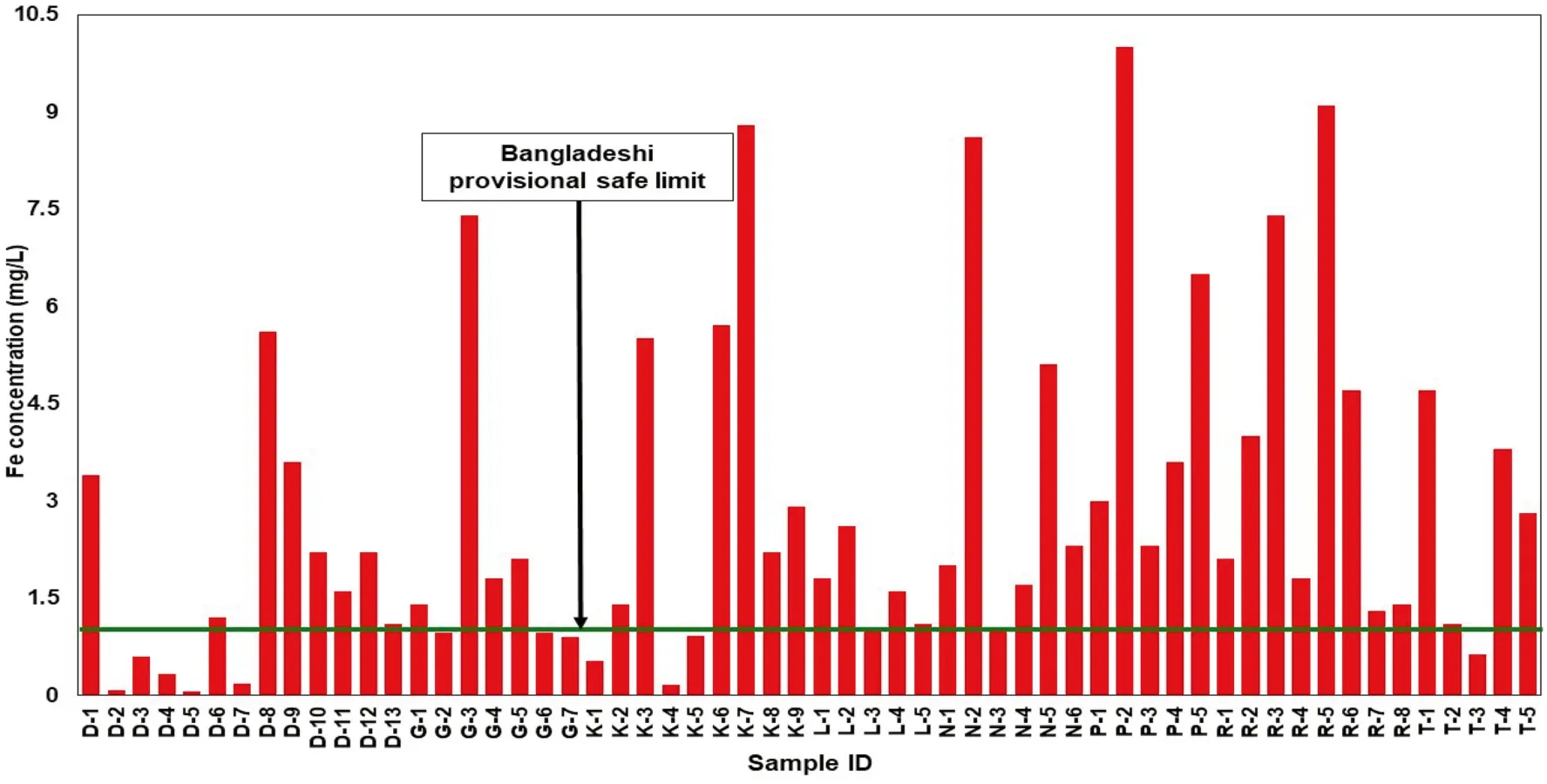
Fig.3 Iron concentration in groundwater (mg L-1) in Rangpur division, northern Bangladesh
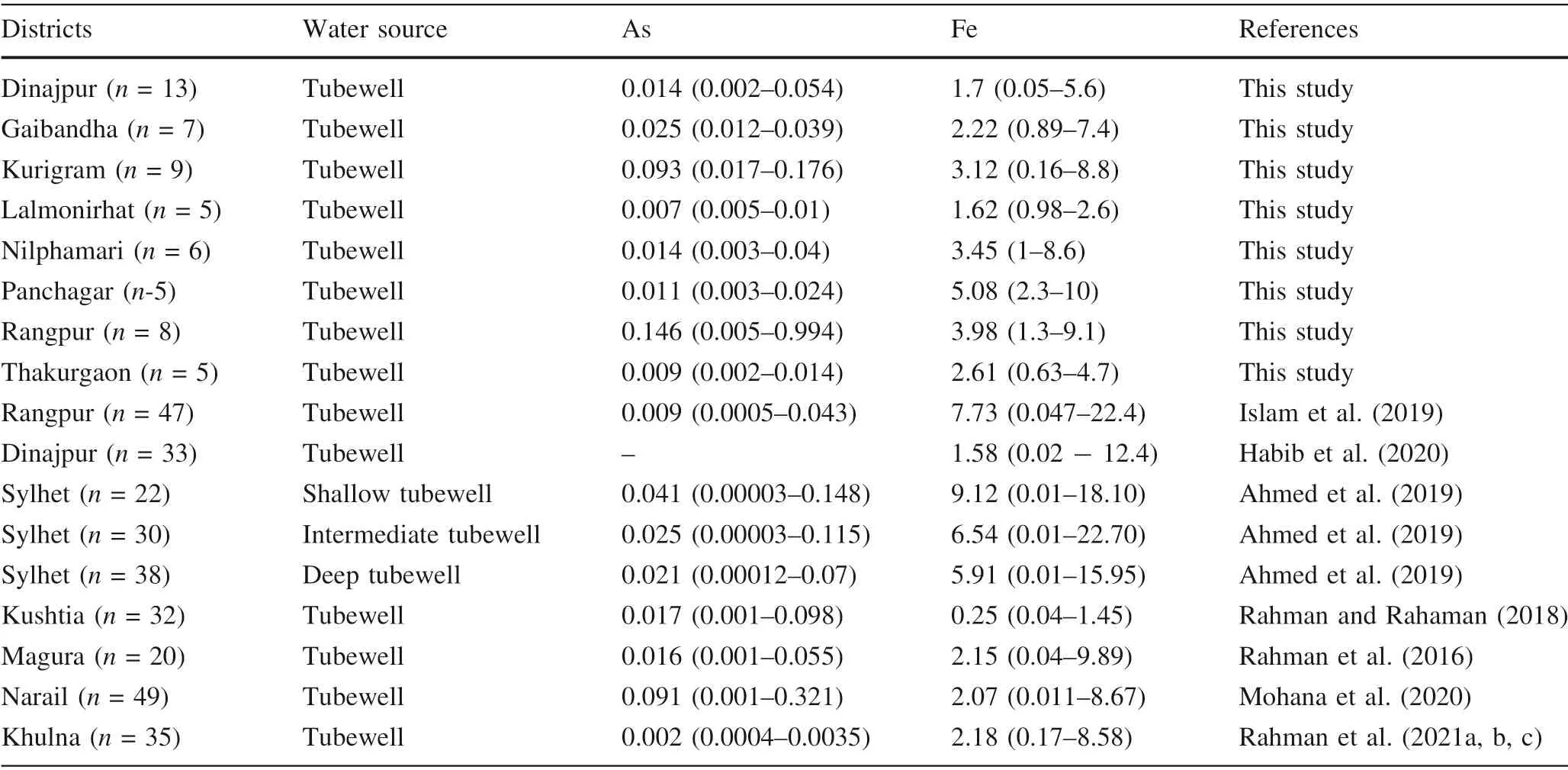
Table 1 Comparison of As and Fe level (mg L-1) in drinking water with other recent studies in Bangladesh (mean and range)
Taking into account tubewell water from primary schools, a large difference (about 2–3 times higher) was observed in As concentration between southwestern and northwestern Bangladesh (this study area).In this study,the average As concentration was 0.044 mg L-1, while in Magura district it was 0.016 mg L-1(Rahman et al.2016),and in Satkhira district it was 0.026 mg L-1(Rahman and Hashem 2019).Although the reported As concentration is lower than the present study,it is still higher than the WHO provisional guideline limit of 0.01 mg L-1(WHO 2011).
Generally, there is a difference in geological characteristics over a large area.So, the difference in As concentration in inter-region contexts might be linked to the hydrogeology of the study area, which is largely related to the depth of a tubewell.In the present study area,there are two types of aquifers, namely the upper shallow aquifer in the uplift zone of Rangpur Saddle and the lower aquifer.The shallow aquifer is characterized by the presence of sands with widespread gravels that formed during the Late Pleistocene to Early Holocene.In contrast,the deep aquifer is characterized by Dupi Tila sand formation overlaid by the thick silty clay that was formed during the Pleistocene(Islam et al.2019).Meanwhile, the geology of the southwestern region is characterized by Pleistocene-Modhupur clay underlying the fluvial-deltaic sediment of the Holocene.The Holocene sediment is mainly composed of quartz with some plagioclase and potassium feldspars, with some fragments of volcanic, metamorphic, and sedimentary rocks (Halim et al.2010; Uddin and Lundberg 1999).The aquifer in southwestern Bangladesh has three stages,namely,a semiconfined, shallow Holocene aquifer (extend 100 m below ground level)that is vertically separated from two Pleistocene aquifers (extend 200 and 300 m below ground level)(Burgess et al.2011;Rahman et al.2011).In the Holocene aquifer,there is a higher level of groundwater As,which was caused by the natural release of As into the aquifer through reductive dissolution of arsenic-rich iron oxyhydroxide (Nickson et al.1998; Saha et al.2020).Nevertheless, anthropogenic activities are also responsible for the release of As in groundwater.
It is important to note that in north-western Bangladesh,tubewell depth is shallower (about 10–53 m) than in the south-western part (about 13–220 m) (Islam et al.2019;Rahman and Hashem 2019).It was reported that As concentrations in shallow, intermediate and deep tubewells were 0.041, 0.0253, and 0.02138 mg L-1, respectively,which is a gradual decline in As concentration from shallow to deep tubewell (Ahmed et al.2019; Mohana et al.2020).Consequently, it is apparent that tubewells in southwestern Bangladesh collect water from the Pleistocene aquifer that is in an oxidized state, which reduces the mobility of As in groundwater.However, in northwestern Bangladesh, tubewells do penetrate into the Holocene aquifer having the reducing condition that facilitates mobilization of As into groundwater.A recent study on hydrogeochemistry also indicated that As concentration reduces with increase in aquifers depth as the condition of the aquifer changes from oxidizing to a reducing state.The reducing state was confirmed by the dominance of some ions, for example, 84% of samples of the Holocene aquifer showed the dominance of As (III)species with Fe2+and Mn2+(Saha et al.2020).Furthermore, a higher As concentration was observed in this area.
The BDWQ standard of Fe in drinking water is 0.3–1.0 mg L-1(BSB/UNICEF 2011; ECR 1997), while there is no WHO guideline value for Fe in drinking water(WHO 2017).In this study, Fe content ranged between 0.05 and 10.0 mg L-1with an average Fe content of 2.84 mg L-1(Supplementary Table S1).The average value for Fe in this study was 2.84 mg L-1,which is about 3 times higher than the maximum permissible limit of 1 mg L-1(ECR 1997).It was observed that about 75.86%(44 out of 58) of drinking water sources contained Fe content higher than the BDWQ maximum permissible value of 1 mg L-1(Supplementary Table S1).The highest Fe concentration was found in Boda, Panchagar(10 mg L-1), while the lowest was reported in Birgang,Dinajpur (0.05 mg L-1) (Fig.3).There was no large difference in average Fe concentration in different districts in Rangpur division.The average Fe concentrations were 1.7,2.22, 3.12, 1.62, 3.45, 5.08, 3.98, and 2.61 mg L-1in Dinajpur, Gaibandha, Kurigram, Lalmonirhat, Nilphamari,Panchagarh, Rangpur, and Thakurgaon, respectively(Table 1).However, mean Fe concentrations were higher than the maximum permissible limit of the Bangladesh standard.A previous study in Rangpur district found 7.73 mg L-1Fe in groundwater (Islam et al.2019), which is more than double the present study’s findings in Rangpur district (3.45 mg L-1).However, in Dinajpur district Fe concentration was 1.58 mg L-1(Habib et al.2020),which is almost close to what was found in Dinajpur district, i.e.1.7 mg L-1.In Kushtia district (western part of Bangladesh), the average Fe concentration was 0.25 mg L-1(Rahman and Rahaman 2018), which is lower than what this study reported for eight districts (Table 1).The Fe concentration in the south-western part of Bangladesh was reported to 1.25, 2.17, 2.18, and 3.6 in Magura, Narail,Khulna, Satkhira district, respectively in past studies(Mohana et al.2020;Rahman et al.2016,2021a,2019).In line with As,the higher level of Fe in groundwater may be attributed to its natural origin in soil, rock, and minerals that undergo dissolution through interaction with groundwater.The reducing condition of the Holocene aquifer, a higher concentration of Fe and As coupled with the basic nature (pH = 6.9–8.8) of groundwater in the study area(Islam et al.2017b) suggest the natural release of Fe from Fe and Mn oxyhydroxides (Ravenscroft et al.2015).Additionally, the prevailing condition of the aquifer might have assisted the release of As-bearing Fe and Mn-oxyhydroxides from the organic-rich sediment as follows(Nickson et al.2000; McArthur et al.2001; Anawar et al.2004; Islam et al.2004):
4FeOOH + CH2O(organic matter) + H2CO3= 4Fe2++ 8HCO32-+ 6 H2O.
2MnO2+ CH2O(organic matter) + H2CO3= 2Mn2++ 4HCO32-+ 2 H2O.
3.2 Human health risk assessment
In this study, health risks to school-going children were estimated for school time only in terms of noncarcinogenic and carcinogenic health risks.The non-carcinogenic health risk was assessed based on chronic daily intake (CDI) of metals, hazard quotient (HQ), and hazard index (HI) for both boys and girls.In addition, carcinogenic risk (CR) was calculated for As, since only As has oral slope factor value between As and Fe.
For each sampling point, the CDI values of As and Fe from the consumption of drinking water in the case of both boys and girls are presented in Fig.4.Descriptive statistics for CDI of As and Fe in eight districts as well as in Rangpur division are provided in Table 2.In Rangpur division, CDIs of As were 0.0018 ± 0.0054 and 0.0022 ± 0.0066 mg kg-1day-1for boys and girls,respectively.The lowest CDI of As was observed for boys(0.0003 ± 0.0001 mg kg-1day-1)in Lalmonirhat district,whilethehighestwasobservedforgirls(0.0073 ± 0.0172 mg kg-1day-1) in Rangpur district(Table 2).
CDI of Fe was higher than As and the CDIs of Fe were 0.1151 ± 0.1014 and 0.1420 ± 0.1252 mg kg-1day-1for boys and girls, respectively in Rangpur division (Table 2).The highest CDI of Fe was observed for girls(0.2540 ± 0.1590 mg kg-1day-1) in Panchgar district,while the lowest was observed for boys(0.0655 ± 0.0262)in Lalmonirhat district.This outcome indicated that the CDI of Fe is higher than As due to the higher concentration of Fe than As in groundwater.As well, the girls ingest more As and Fe than the boys, this being caused by the different body weights of boys and girls.The boys are heavier than the girls are and this guides their CDI of As and Fe through drinking water.
The HQ and HI for each primary school in the study area are depicted in Figs.5 and 6.
It is apparent that HQ was higher for As intake than Fe.The average HQs for As intake through drinking water were 6.01 ± 17.85 and 7.41 ± 22.03 for boys and girls,respectively (Table 3), which is 6 and 7 times higher than threshold value of 1, indicating severe non-cancer health risks to the students.In every district the average HQ from As intake for boys and girls was higher than 1, except for boys(0.99 ± 0.31)in Lalmonirhat district;however,it was very close to 1 (Table 3).The highest HQ from As intake was noted in Rangpur district for both boys(19.74 ± 46.37) and girls (24.35 ± 57.22).Added to this,the highest HQ was observed for sampling point R-2(boys:134.25 and girls: 165.67), which is in Rangpur district indicating the highest non-cancer risks to the students of this school (Fig.5).Referring to Fe intake, the average HQs for boys and girls in Rangpur division were 0.15 ± 0.14 and 0.2 ± 0.18,respectively,and in all of the eight districts HQs for Fe intake were lower than threshold value of 1.Suggested here is that there is no non-cancer risks to the students.
The HI is the sum of HQ for As and Fe intake from drinking water.Since HQ from As is dominant over Fe,the HI for boys and girls follows the similar trend of HQ for As.In this study, the average values of HI for boys and girls were 6.16 ± 17.87 and 7.61 ± 22.1, respectively,which is similar to HQ for As intake (Table 3).In southwestern Bangladesh, HQ for As intake with reference to school going children was also higher than 1, but it was much lower than what Rahman and Hashem (2019) documented.They reported the highest HQ for As in Kaligonj,Satkhira(HQ = 6.34),which is about 3–4 times lower than the highest HQ value found in this study.Therefore, the exposed population is at a level of serious health concern,for example, it can cause mild respiratory effects, such as dry cough and asthma in females,but pronounced effects in males exposed to high concentrations of As in drinking water in the early stages of life(Khan et al.2020).Children are likely to experience respiratory symptoms, pediatric pneumonia, cardiovascular diseases, and cancers of the bladder, lung, and kidneys (Osorio-Yáez et al.2013;Osorio-Yáez et al.2015;Rahman et al.2013;Smith et al.2013), neurological disorders and altered neurobehavioral development in adolescents in the study area (Osorio-Yáez et al.2013; Yorifuji et al.2016).

Fig.4 Chronic daily intake (CDI) of Arsenic and Iron from drinking water by children and adults in Rangpur division, northern Bangladesh
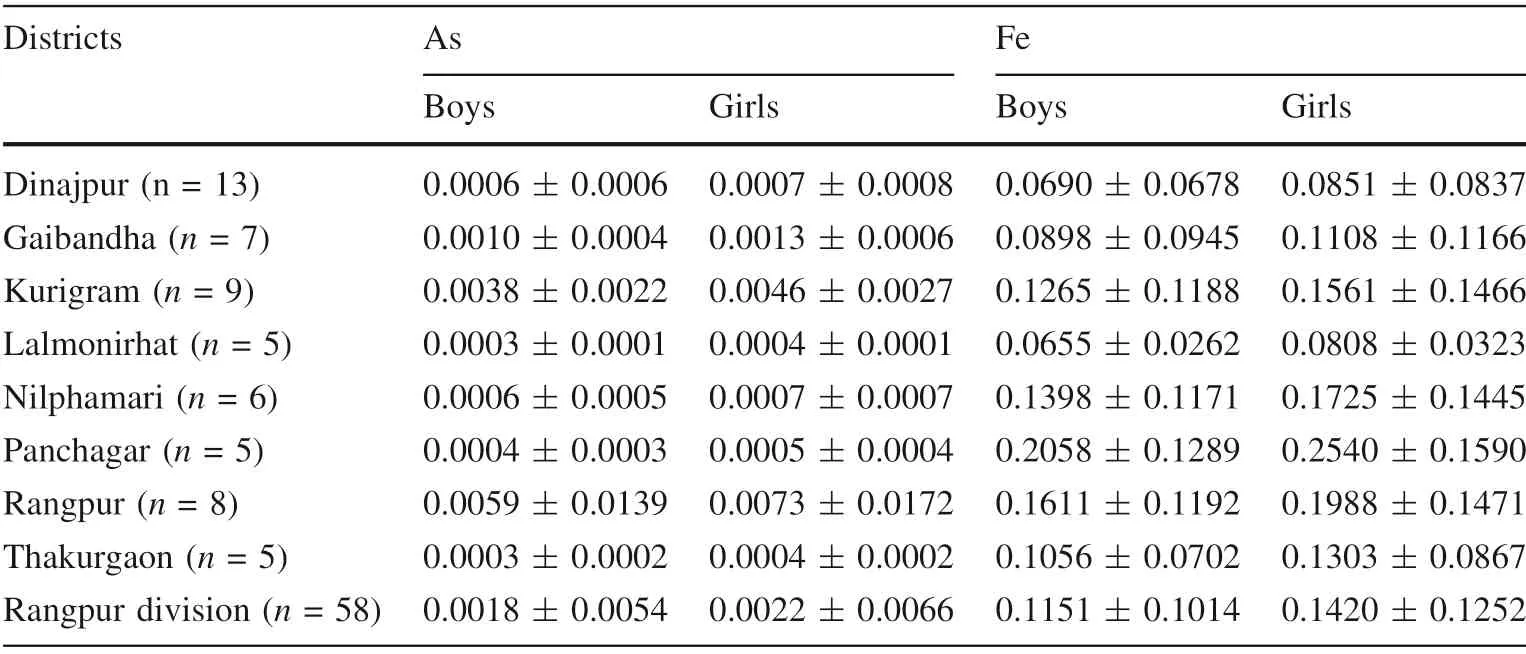
Table 2 Descriptive statistics for chronic daily intake(CDI)of As and Fe (mg kg-1 day-1)from drinking water in eight districts of Rangpur division
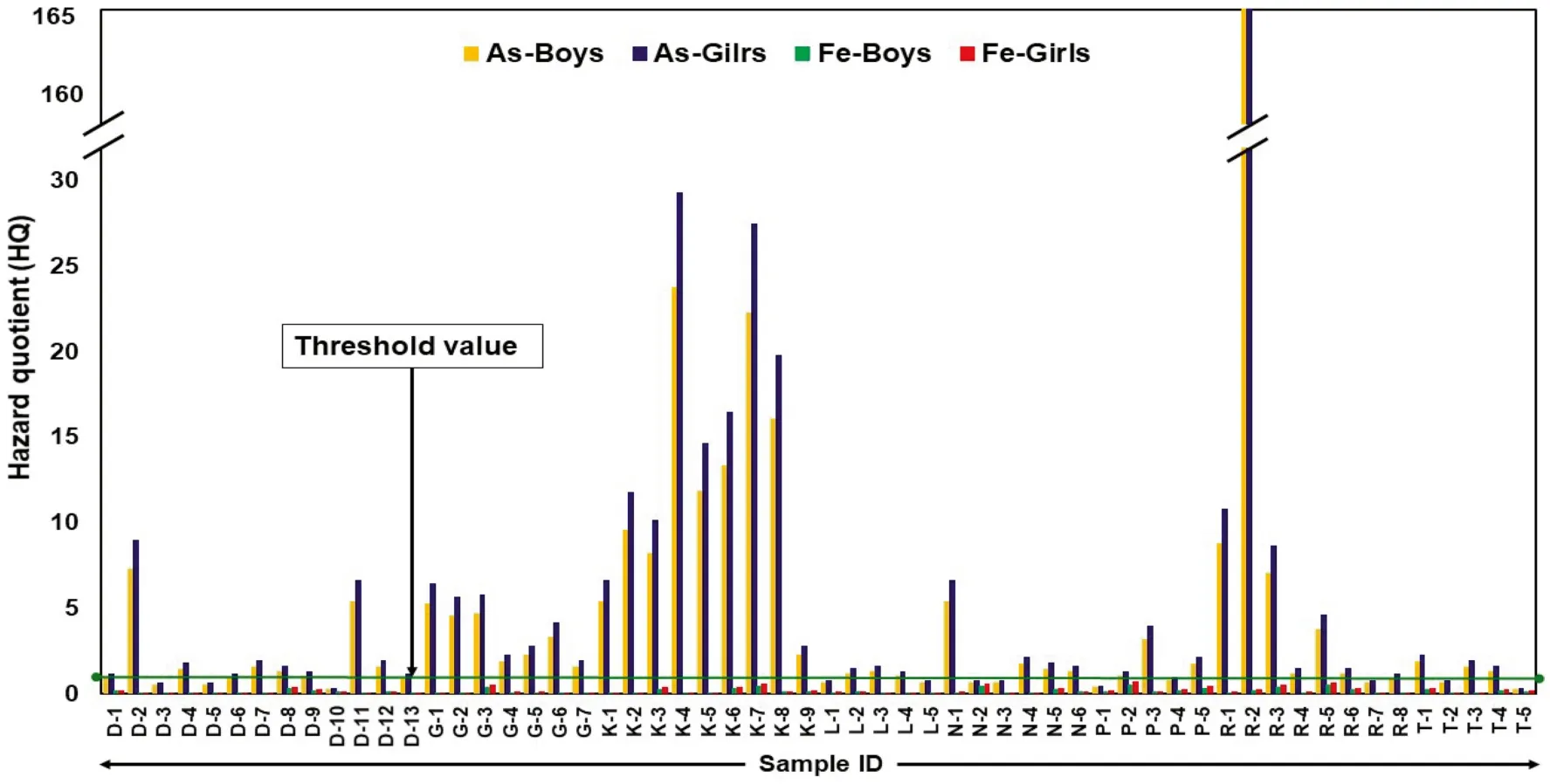
Fig.5 Hazard quotient (HQ) of Arsenic and Iron from drinking water in Rangpur division, northern Bangladesh

Table 3 Hazard quotient (HQ) and Hazard Index (HI) of As and Fe (unit less) from drinking water in eight districts of Rangpur division
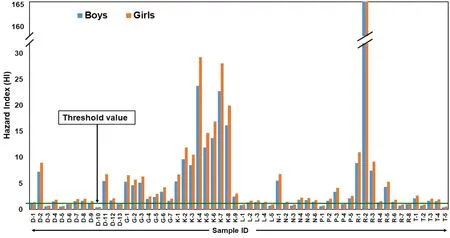
Fig.6 Hazard index (HI) of Arsenic and Iron from drinking water in Rangpur division, northern Bangladesh
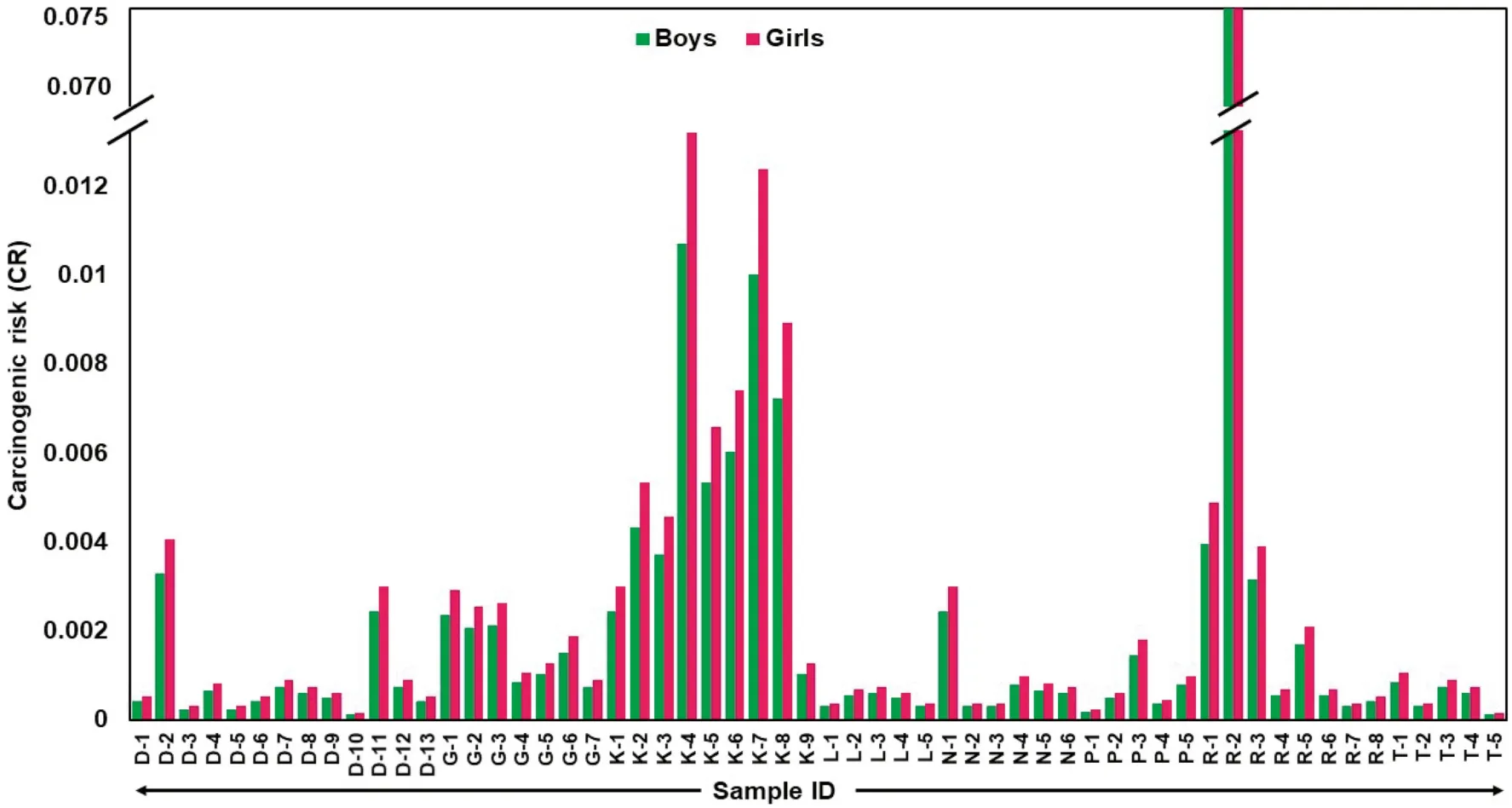
Fig.7 Carcinogenic risk (CR) of Arsenic from drinking water in Rangpur division, northern Bangladesh
Figure 7 shows the estimated CR value of As for both school-going boys and girls.Besides, CR of As for each district in Rangpur division is provided in Table 4.In Rangpur division, it was observed that average CR values for both the boys (0.0027 ± 0.008) and girls(0.0033 ± 0.0099) exceeded the threshold limit of 10–6–10–4provided by US-EPA (USEPA 2015).The CRs were 2.7 and 3.3 times higher than the highest threshold limit of 10–4.Besides, average CR values for each district in Rangpur division exceeded the threshold value.The highest CR was found for girls (0.011 ± 0.0258) in Rangpur district, while the lowest was found for boys(0.0004 ± 0.0001)in Lalmonirhat district(Table 4).Based on this, it is evident that As in drinking water may cause lifetime cancer risk, particularly, skin, liver, lung, kidney,and bladder cancer to the primary school students in the study area (Smith et al.1992).
3.3 Correlation between As and Fe
There were 26 water samples out of 58 having As concentration <0.01 mg L-1.Among 26 samples having As <0.01 mg L-1, 25 samples had Fe concentration higher than maximum contamination level (MCL) of 0.3 mg L-1and 22 samples had a concentration higher than BDWQ level of 1 mg L-1.No significant correlation between As vs.Fe (r2= 0.0479) was observed in tubewell water when the As concentration <0.01 mg L-1in the studied area (Fig.8A).Similarly, there was 32 water samples having As concentration >0.01 mg L-1, where 30 water samples had Fe concentration higher than MCL by US-EPA(2017)and 23 water samples had concentration higher than BDWQ level of 1 mg L-1.No significant correlation was found between As vs.Fe(r2= 0.0105)wasobserved in tubewell water when the As concentration >0.01 mg L-1(Fig.8B).
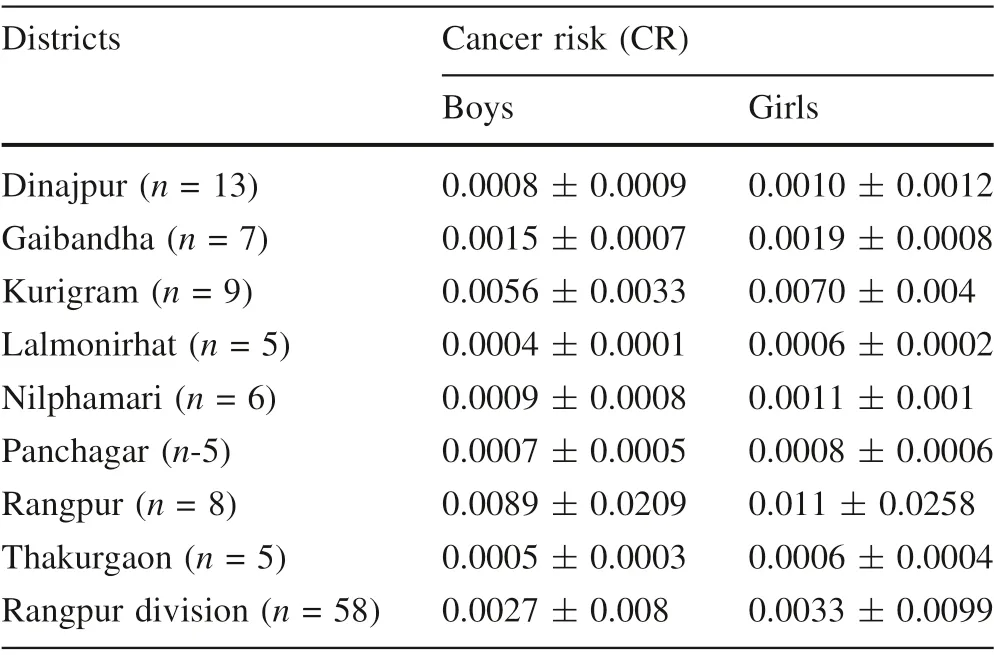
Table 4 Carcinogenic risk (CR) of As from drinking water in eight districts of Rangpur division
4 Conclusions
The tube well water samples were collected from eight districts of Rangpur Division (north-western part of Bangladesh) to understand the pollution level and possible health risks of As and Fe to the school-going children at a primary educational institution.It was observed that Rangpur is an extensively As polluted district among eight districts in Rangpur division.About 55.17%(32 out of 58)samples contained higher As concentration than the WHO provisional guideline value,whereas,about 18.97%(11 out of 58) groundwater contained higher than the BDWQ standard limit.A large difference in groundwater As content in north-western and south-western Bangladesh was observed,which was due to the depth of tubewells.Clearly,in north-western Bangladesh, tubewell depth is smaller regarding the penetration in the Holocene aquifer,which is reductive in nature and releases more As into groundwater.On the other hand, in southwestern Bangladesh, tubewells are deeper than is inserted into the Pleistocene aquifer,which is characterized by oxidization that releases the least As or suppresses the release of As into groundwater.It also emerged that Fe concentration was higher and about 75.86% (44 out of 58) drinking water sources contained more Fe than the BDWQ standard level of 1 mg L-1.Similar to As, the geological factors control the release of Fe in north-western Bangladesh.
Health risk assessment showed that the CDI of Fe is higher than As due to the higher Fe concentration in groundwater.In addition,regarding gender differences,the HQ and CR for girls were higher than the boys,so the girls are more prone to cancer and non-cancer risks.The HQ from As intake is higher than the threshold value of 1,while the HQ from Fe intake was much lower than the safe value.This is an indication that As may pose lifetime noncancer risks to school-going children in the study area.Apart from this, there is a higher possibility of enduring lifetime cancer risks from drinking this contaminated water.
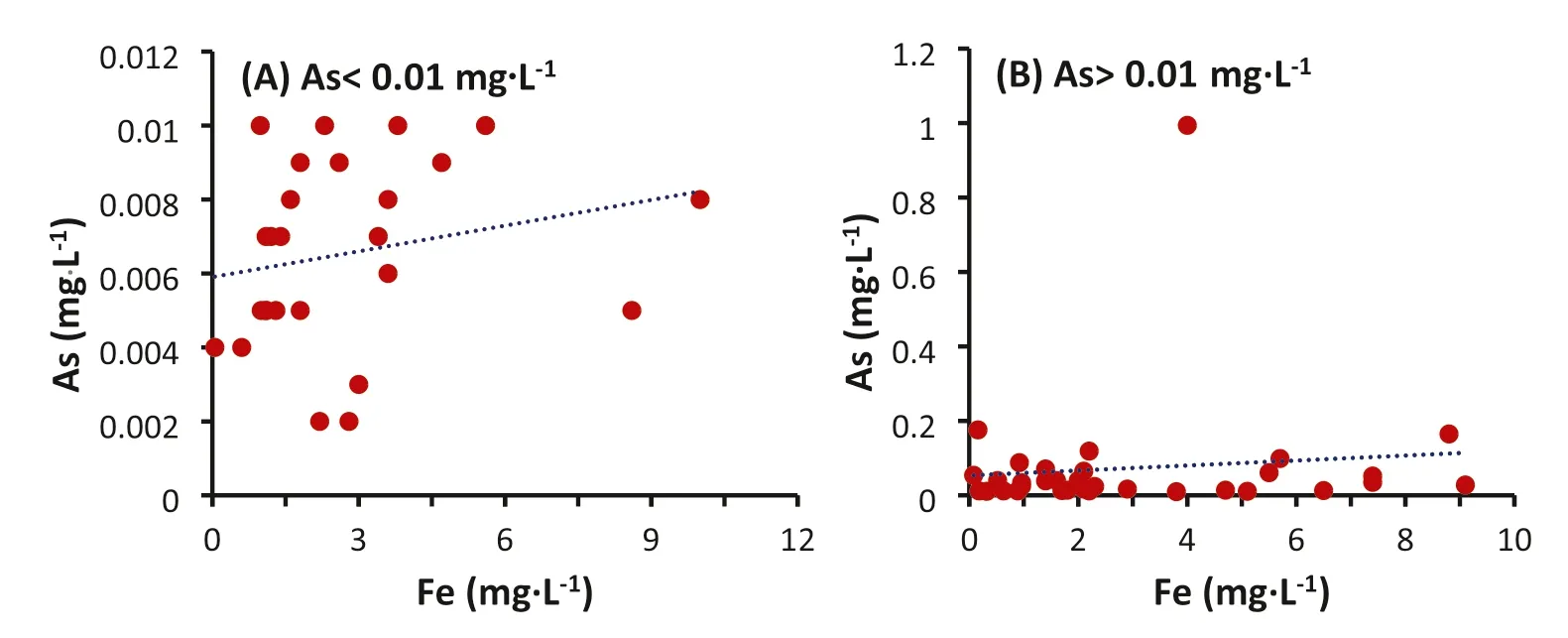
Fig.8 Bivariate scatter plot(A) As vs.Fe, when As concentration is <0.01 mg L-1; and(B) when As concentration is >0.01 mg L.-1
Therefore, this study suggests that it is necessary to drinking tubewell water in the investigated schools and find another way to remove As from drinking water.The Pleistocene aquifer which is a deeper aquifer is not a safe alternative source as it was observed that deeper aquifers contain less As, but nonetheless may cause lifetime cancer risks to children.For this reason,cost-effective arsenic iron removal plants (AIRPs) (Rahman et al.2021b) and SONO filters (one type of efficient As-Fe removal plant) can be installed in school premises to reduce As and Fe from raw drinking water to a safer level.
Supplementary InformationThe onlineversion contains supplementary material available at https://doi.org/10.1007/s11631-022-00563-w.
AcknowledgementsThe authors are thankful to the authorities of all primary schools who allowed and helped the collections of water samples from the respective tube wells.The authors also acknowledge the DPHE Zonal Laboratory,Rangpur for providing facilities for trace element testing.
FundingOpen Access funding enabled and organized by CAUL and its Member Institutions.None.
Data availability The data that support the findings of this study are available on reasonable request from the corresponding author.
Declarations
Conflict of interestThe authors declare that they have no conflict of interest.
Consent to publicationAll authors read and approved the final manuscript.
Ethical approvalNot applicable in this work.
Open AccessThis article is licensed under a Creative Commons Attribution 4.0 International License, which permits use, sharing,adaptation,distribution and reproduction in any medium or format,as long as you give appropriate credit to the original author(s) and the source,provide a link to the Creative Commons licence,and indicate if changes were made.The images or other third party material in this article are included in the article’s Creative Commons licence,unless indicated otherwise in a credit line to the material.If material is not included in the article’s Creative Commons licence and your intended use is not permitted by statutory regulation or exceeds the permitted use, you will need to obtain permission directly from the copyright holder.To view a copy of this licence, visit http://creativecommons.org/licenses/by/4.0/.
杂志排行
Acta Geochimica的其它文章
- Fractionation mechanism of iron isotopes in highly fractionated granites from the Xinxian Pluton,Western Dabie Orogen,Central China
- Fluid inclusion studies of the Kenticha rare-element granitepegmatite, Southern Ethiopia
- Petrogenesis and tectonic implications of Late Triassic granitoids in the Alananshan,East Kunlun belt:evidence from geochemistry,geochronology, and zircon Hf isotopic compositions
- TiO2 nanoparticles in aquatic environments: impact on heavy metals distribution in sediments and overlying water
- Comparing mineral weathering and elemental transport between earth’s critical zone with different parent rocks in Yanshan Mountain, Hebei province, China
- Geochemistry and crystal shape, size and spatial distribution in arc-related gabbro, Urmia, NW Iran
